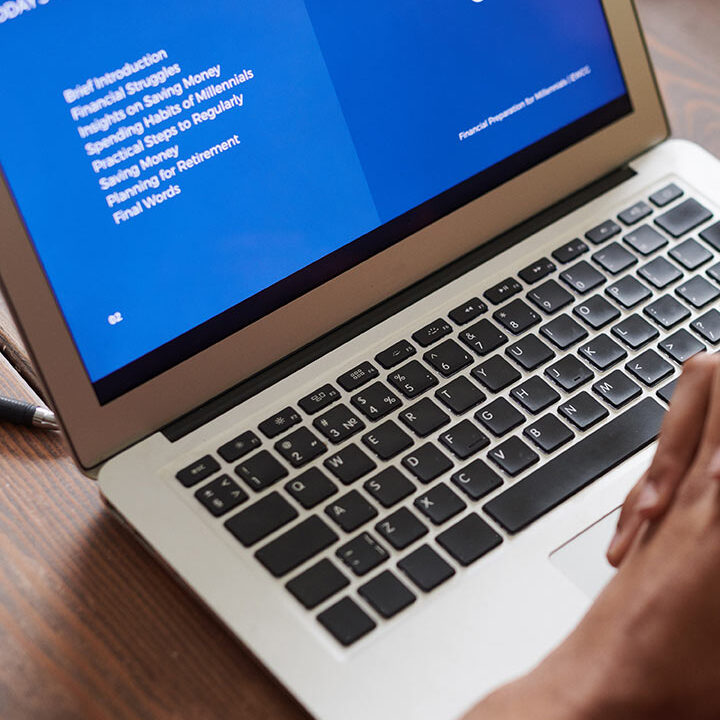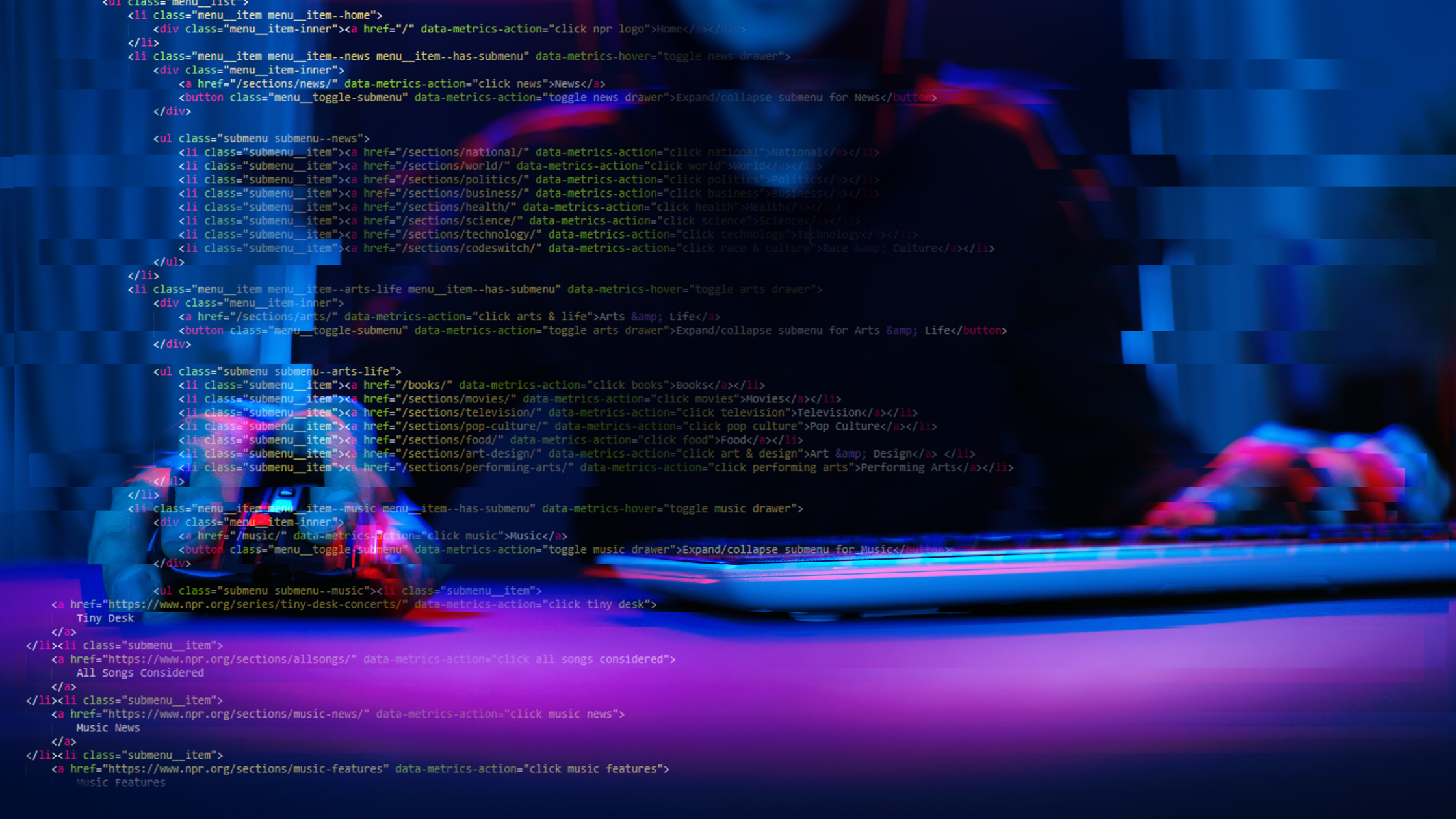Breaking the unbreakable: Story of B0 software group ransomware
This is how deep technical curiosity, DFIR expertise, and persistence led to the downfall of B0 Software Group’s ransomware. In this article, we walk through the full investigation from start to finish: from the initial response and behavioral analysis to reverse engineering and decryptor development. With annotated code snippets, screenshots, and step-by-step breakdowns, we reveal not just what was done, but why it worked.
If you’re looking for a real-world look at how threat intelligence and malware analysis can turn the tide in ransomware recovery, this is it.
Known Tactics, Techniques, and Procedures
Since ransomware groups can often sell their malware to multiple affiliates. These affiliates can have different flavors and attack methodologies for how they breach a targeted network. As such, there is no single set of TTPs that can generally cover how B0 software group ransomware can end up on your network. In this case, however, the DFIR investigation highly suggests that brute-forcing an internet-facing RDP (RDP brute-forcing) was the initial entry point.
The assessment was based on the following factors:
- Evidence of a brute force attack. Found repeated failed logins to the Administrator account on the compromised server. The brute force attempts originated from external IP addresses.
- The default RDP port 3389 was directly exposed to the internet at the time of the incident. The default RDP port is frequently an attractive attack vector and can be easily discovered by automated port scanners such as Nmap.
DFIR Investigation Conclusion
As for activities within the network and lateral movement, the DFIR investigation concluded the following points:
- Network discovery/reconnaissance. Upon gaining access to the server, the threat actor used the network reconnaissance tools Advance IP Scanner and kportscan 3.0 to identify additional devices to which to move laterally. However, because the server was the only device within a segmented, isolated environment, further lateral movement was unsuccessful.
- Account usage and privilege escalation. The threat actor gained access to the privileged Administrator account on the server via a brute force attack. Upon successfully logging into the system, they also created the account B0Us. The threat actor also executed the credential harvesting tool, Mimikatz, on the server. This is a credential dumping tool, typically used by threat actors to obtain any available credentials stored within the memory of a target system.
- Ransomware deployment. The threat actor transferred the compressed file ‘pth.rar’ to the system, which contained their toolkit, including the ransomware executable ‘b0.exe’. The compressed file was initially placed in the directory ‘C:\users\b0us\desktop\’ and then subsequently extracted using the file compression tool, WinRAR. The threat actor placed their ransomware binary within the folder ‘C:\users\public’, manually executing this on the server leading to the encryption of files on the system and creation of ransom notes.
Exfiltration Analysis
We assess that the threat actor did not exfiltrate data from the impacted server. This assessment is based on the following factors:
- No evidence of file transfer tooling. S-RM found no evidence of data transfer tooling that could have been used by the threat actor to exfiltrate data from the server.
- No evidence of data access or staging activities. S-RM reviewed data extracted from the system and did not identify any conclusive evidence typically preceding exfiltration, such as data reconnaissance and compression. While we found evidence of interaction with the server’s data drives, it is likely that this occurred in the context of pre-encryption activities.
- Threat actor claims. The threat actor did not claim to have exfiltrated any data from the server in their ransom note. Further, S-RM found no evidence of a leak site maintained by the threat actor to publish victim data as part of data extortion tactics.
Limitations
- Due to the hosted nature of the server, S-RM could not obtain access to network or firewall logs, typically providing insight into data traffic and volumes. We were therefore unable to determine whether there any significant spikes in outbound data during the timeframe of the incident consistent with exfiltration activities.
- The evidence indicates that a limited number of files were accessed by the threat actor, however there is no accompanying evidence that would show that this data was transferred out of the system.
Technical analysis
The ransomware was written in Golang, making it more challenging to reverse engineer compared to other ransomware variants which are in C/C++.
The compilation timestamp of the analyzed sample was set to zero, which might have been a tactic used by the authors to confuse analysts and make it more difficult to determine when the sample was compiled. Notably, the ransomware includes its own kill switch. It calculates the time difference between a hardcoded UTC timestamp of March 24, 2025, at 00:00:00, and the time when the sample is executed. The ransomware checks if this time difference falls within a 3-day range. If it does, the ransomware continues its normal execution. If not, it immediately restarts the system by executing the command “shutdown /r /t 0”.

After confirming that the process runs within the allowed time range, it moves on to another check. During this check, it prompts the user for a password and a network ID. The provided password is then hashed using SHA-256 and compared against a hardcoded hash. If the hashes match, the execution will proceed; otherwise, it will prompt for the password again, up to three times. If all three attempts fail, the process will exit.
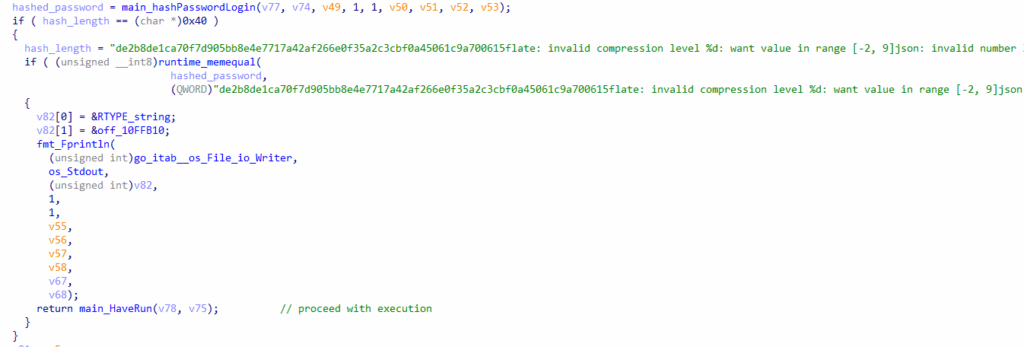
Upon successfully completing all the previously mentioned checks, the process moves on to configure the setup. First, it initializes a pseudo-random number generator using the current system time obtained by calling “time.Now.UnixNano().” Next, it generates a random nine-character string that will later be used for the key derivation function. This key will be crucial for the decryption and recovery of ransomware, which we will discuss later.

Next, it will verify the existence of the JSON file “telemetry.ASM-WindowsDefault.json” located in “C:\Windows\System32”. This JSON file contains the ransomware configuration, including the initial key (a random nine-character string), the extension, and the Network ID.

If the file is found, it continues by reading the file and setting the corresponding global variables for ransomware configuration.

Similar to the key file, it will check for the existence of a file “Icon.png”, located in the Windows directory “C:\Windows”. Same as before, if the file is not found, it proceeds to create it. The icon file contents are stored as base64 encoded text that will be decoded and written to the file at run-time.
If the file was not found, it then creates the file “Icon.png” and sets the default icon for files with the ransomware’s extension (as specified in the ransomware configuration) to this “Icon.png.”
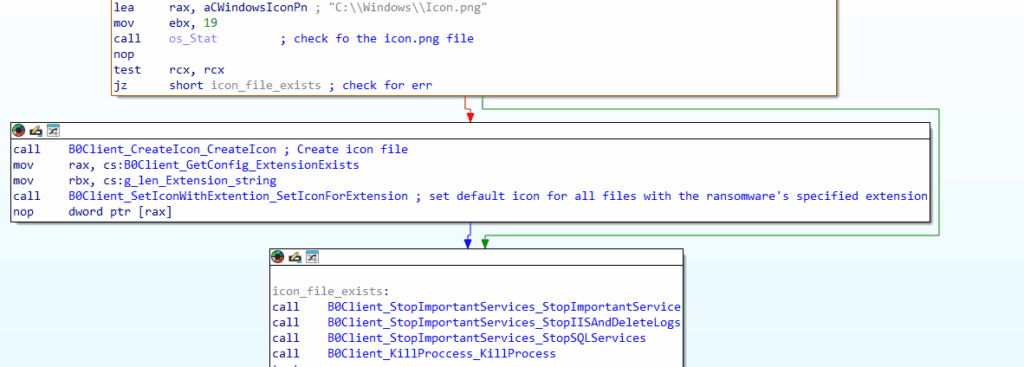
Process and Service targeting
Before proceeding with key derivation and encryption, the ransomware will attempt to stop related services for Windows IIS, MSSQL, and MySQL by executing the commands listed below.
BlockListed services
- cmd /C iisreset stop
- cmd /C NET STOP IISADMIN
- cmd /C net stop WAS
- cmd /C NET stop MSSQLSERVER
- cmd /C NET stop \”SQL Server (MSSQLSERVER)\”
- cmd /C net stop MSSQL$SQLEXPRESS
- cmd /C net stop SQLSERVERAGENT
- cmd /C net stop mysql
- sc stop W3SVC
- sc stop WAS
- sc stop IISADMIN
It’s important to note that not only it targets specific services by name but also attempts to obtain a list of running services and processes using the commands “sc query” and “tasklist.” Additionally, it tries to terminate any service or process that contains the word “SQL” in its name.
Anti-forensics measures
The ransomware deploys a variety of anti-forensic measures, to avoid leaving behind any leads that can be used in a forensic investigation. The following is a list of the anti-forensics’ measures taken by the ransomware to wipe any evidence.
- Delete the Windows IIS logs located in the directory: C:\inetpub\logs.
- Empty the Recycle Bin.
- Constantly clears Windows Event Logs.
- Constantly Clear the contents of the Windows Temp folder by running the following command:
Del /S /F /Q %Windir%\Temp- Create a registry entry under the Run key to clear Windows Event Logs upon user login. Use the following command:
powershell.exe -Command New-ItemProperty -Path HKCU:\Software\Microsoft\Windows\CurrentVersion\Run -Name DeleteLogWithStartUp -Value 'powershell wevtutil el | ForEach-Object { wevtutil cl $_ }' -PropertyType String
This will ensure that the Windows Event Logs are cleared each time the user logs in.
Furthermore, the following commands are written to a file called “Del.cmd,” which is saved in the system directory C:\Windows\System32\ and executed. This script will delete the ransomware executable as well as the Windows Event logs.
Contents of Del.cmd, that will be executed after encryption to wipe any traces of its activity
timeout /t 10
del /f ransomware_executable_path
powershell "wevtutil el | Foreach-Object {wevtutil cl "$_"}It is noteworthy to mention that the ransomware does not delete the Windows Event Logs; instead, it continuously clears them during execution to erase any traces of its activity. The same behavior applies to the Windows Temp folder.

Key Derivation
The initially generated random nine-character string is used to generate the AES-GCM key, which is then used during encryption. The ransomware first uses the hashids library to generate a hashed ID using the random string as the salt and 1,000,000,000(0x3B9ACA00) . This library can generate hashed/obfuscated IDs from numbers. The hashed ID’s size is 7 bytes, and its character set is limited to ‘abcdefghijklmnopqrstuvwxyzABCDEFGHIJKLMNOPQRSTUVWXYZ1234567890’.

The hashed ID is then hashed in the following order: SHA1 → MD5 → SHA512 → SHA1 → MD5 → MD5 → SHA1 to generate a password that will be used in the password based key derivation function. The hashing functions also encode the hashed data before returning it.

After this, PBKDF2 is used to derive the AES-GCM key from the password. The salt is the same as the password; 100,000 iterations are used, and the key length is 32 bytes. SHA512 is used as the hash function for the password based key derivation function. Notably, if a null value is passed as the salt(that indicates for some reason it failed to generate and hash the random nine-character string), the ransomware generates a random salt using the crypto/rand package; however, if this occurs, it is impossible to decrypt the file even with the threat actor’s decryptor, since the ransomware does not store the salt somewhere. Regardless, this scenario would not happen, as the third argument is always the password converted to bytes in the current version of the ransomware.

The resulting key is used to encrypt the files with AES-GCM, and the same key is used for each file.
Ransom Note
As is common to ransomware groups, a note with instructions on how to contact the actor is dropped in each driver’s root directory. The victim can negotiate payment options via a communication channel of the actor’s choosing. The note is dropped in two forms : a text file, How_To_Recovery_Files.txt, and an HTML file also named How_To_Recovery_Files.html with slightly different content.
It is worth mentioning that the Network ID(serves a unique identifier to the victim) provided earlier in the early of its execution, is added to the contents of the ransom note before it’s written to disk.



File Encryption
The main_FindFile function retrieves a list of the root directory paths for each available drive letter, and then calls main_run on each.

The main_run uses filepath.Walk() to recursively walk through all the files, and directories. The callback function passed as an argument to filepath.Walk() performs some checks on the file path to decide whether the file can be encrypted or not. It first checks whether any of the following blacklisted paths are in the filepath, and if they are, the callback function returns without encrypting the file.

Below we summarize the list of paths excluded by the ransomware during encryption.
BlackListed Filepaths:
- \WindowsPowerShell\Modules\
- \Windows
- \ProgramData
- \Program Files\Reference Assemblies\
- \Program Files\Common Files\
- \Program Files\Internet Explorer
- \Program Files (x86)\Reference Assemblies\
- \Program Files (x86)\Common Files\
- \Program Files (x86)\Internet Explorer\
- \Program Files\WindowsApps\
- \Program Files\Embedded Lockdown Manager\
- \Program Files\VMware\
- \ProgramData\Microsoft\
- \$Recycle.Bin\
The next check determines whether the ransomware extension is at the end of the file, and whether the extension is .ini or .sys. If it is either of these, the file is skipped. After this, it checks whether the extension is .bak or .log, and if it is, it proceeds with deleting the file and returning. If a file doesn’t pass any of these checks, the encryption function is called on it. Since these checks do not check whether the file is the ransomware executable itself, the ransomware ends up encrypting its own executable. However, it fails to remove the plaintext executable after the encryption process using os.remove.
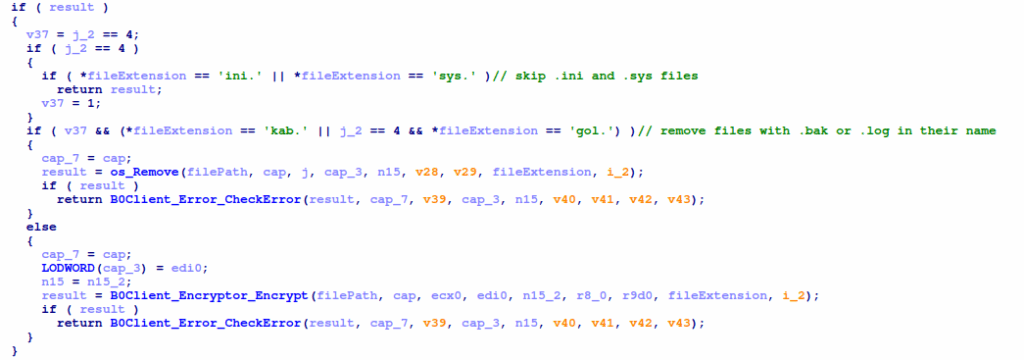
The file encryption function first prints the filepath. After which, it attempts to open the file. If that fails, the ransomware just skips the file instead of trying to kill the process that’s using the file. The ransomware also checks that the file is not a directory after opening it.
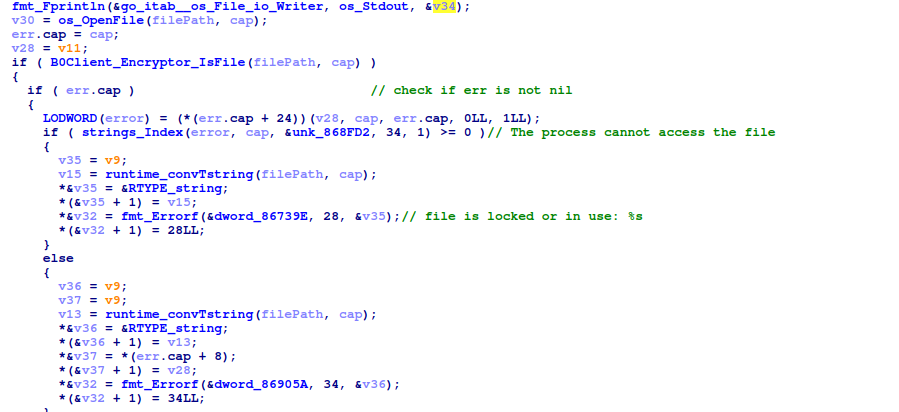
The ransomware initiates the encryption process by generating an AES cipher object and initializing it with the previously generated key. It uses GCM mode with a 16-byte tag size and a 12-byte nonce size. The nonce is randomly generated using the crypto/rand package.
![A screenshot of C/C++ code that uses crypto_aes_NewCipher to create a new cipher. If successful, it prints an error message using fmt_Error; otherwise, it uses crypto_cipher_newGCMWithNonceAndTagSize and crypto_rand_Read to generate a nonce and tag. A memory address MEMORY[0x14] is highlighted in red.](https://www.porthas.com/wp-content/uploads/2018/05/image18.png)
After this, the ransomware creates a new file named by appending .id-. to the original filename. The initially generated key is stored both in the configuration file and within each encrypted file’s name. The ransomware then writes a 16-byte marker, consisting of null bytes, followed by the random nonce, to the new file. After this, it reads data from the original file in chunks of 0x400000 bytes, encrypts each chunk using the Seal() function, which handles both encryption and authentication. The resulting ciphertext, along with the 16-byte authentication tag, are both written to the new file. Once all chunks have been encrypted and written, the original file is deleted using os.remove.
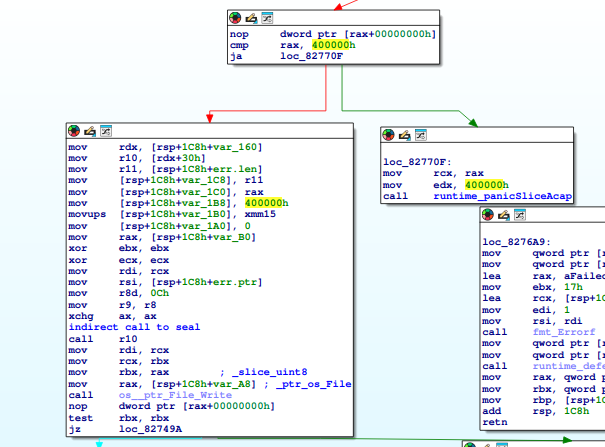
Encrypted file structure
The structure of the encrypted file is quite straightforward. At the beginning of the encryption process, a 16-byte marker (highlighted in purple) consisting of NULL bytes is added to the start of the file to indicate that it is encrypted. Following this marker, there is a 12-byte nonce (highlighted in Red in the screenshot below) value that remains consistent throughout the entire file. This nonce is stored within the file for use during decryption later. The rest of the data is just the file’s encrypted data (highlighted in light green in the screenshot below).

Weakness
There are two major weaknesses in the encryption. The first, and most obvious, is that the AES‑GCM key can be easily derived from the initial key (randomly generated nine-character string), which is unique to each victim and generated at run-time, then saved to disk later.
The second weakness is less apparent. Although the ransomware uses AES‑GCM to encrypt blocks (which combines AES‑CTR for encryption and GMAC for authentication), it doesn’t generate a new nonce for each block. As a result, the same keystream is reused for each block within a file. If we know the plaintext for one block, we can recover the keystream by xoring it with the corresponding ciphertext and then use that keystream to decrypt all subsequent blocks. However, exploiting this vulnerability is not straightforward, since it requires a significant amount of known plaintext (0x400000) bytes.
Decryptor
We have created a b0 ransomware decryptor for those affected by this ransomware. Errors are logged in .\log.txt. Below is the usage guide.
Usage of decryptor:
- dirpath string: Path to the directory to recursively decrypt files
- key string: Key to use for decryption, in the following filename test.pdf.id-QVKGBICKS.B0-3e72d, QVKGBICKS is the key.
- path string: Path to the encrypted file
Indicators Of Compromise
Known hashes
cea74b854b6cd161884e5ced5c8b7ba44c1064ff22703667cc913d9a67f1767b (SHA-256)
File Paths
| Ransomware executable | B0.exe |
| Ransomware configuration written to disk at run-time | C:\Windows\System32\ telemetry.ASM-WindowsDefault.json |
| Ransomware icon | C:\Windows\Icon.png |
| Batch script | C:\Windows\System32\Del.cmd |
| Ransom note in text and HTML versions | C:\How_To_Recovery_Files.txt C:\How_To_Recovery_Files.html |
| Registry entry created to clear Windows Event logs on user login | HKCU:\Software\Microsoft\Windows\CurrentVersion\Run\ DeleteLogWithStartUp |
Conclusion
This investigation is a powerful reminder that even in an ecosystem dominated by rapidly evolving ransomware threats, there’s still room for skilled analysis, persistence, and creative problem-solving to make a real impact. While not every case ends in a decryptor, this one proves that deep malware analysis and DFIR expertise can tip the scales.


